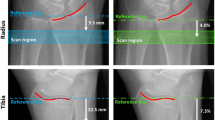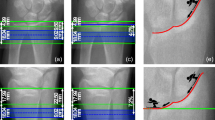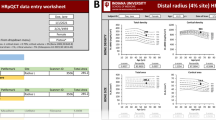Abstract
High-resolution peripheral quantitative computed tomography (HR-pQCT) is increasingly being used in the research setting to assess the effects of osteoporosis treatments and disease on trabecular and cortical bone compartments. Further in-depth study of HR-pQCT measurement variables is essential to ensure study strength and statistical confidence when designing large multicenter studies. Duplicate HR-pQCT examinations of the distal radius and tibia were performed in 180 healthy men and women ages 16–18, 30–32, and >70 years. HR-pQCT images were processed using standard and extended cortical bone analysis techniques. Biomechanical properties of bone were assessed using finite element analysis. Percent root mean square coefficient of variation (RMSCV) was calculated for each measurement variable. Age, site, and gender influences on measurement variability were investigated using variance ratio tests. Smaller precision errors were observed for densitometric (0.2–5.5 %) than for microstructural (1.2–7.0 %), extended cortical bone (3.4–20.3 %), and biomechanical (0.3–9.9 %) measures at both the radius and tibia. Tibial measurements (RMSCVs = 0.2–7.4 %) tended to be more precise than radial measurements (RMSCVs = 0.7–20.3 %). Variability was influenced by age, site, and gender (all p < 0.05). HR-pQCT measurements for the tibia were more precise than those for the radius, and this may be explained by the larger bone volumes examined and the reduced likelihood of movement artifact. The greater measurement variability observed for older volunteers may be due to the loss of bone density and microstructural integrity with age.


Similar content being viewed by others
References
Boutroy S, Bouxsein ML, Munoz F, Delmas PD (2005) In vivo assessment of trabecular bone microarchitecture by high-resolution peripheral quantitative computed tomography. J Clin Endocrinol Metab 90(12):6508–6515
MacNeil JA, Boyd SK (2007) Accuracy of high-resolution peripheral quantitative computed tomography for measurement of bone quality. Med Eng Phys 29(10):1096–1105
Burghardt AJ, Kazakia GJ, Majumdar S (2007) A local adaptive threshold strategy for high resolution peripheral quantitative computed tomography of trabecular bone. Ann Biomed Eng 35(10):1678–1686
Recker RR, Delmas PD, Halse J, Reid IR, Boonen S, García-Hernandez PA, Supronik J, Lewiecki EM, Ochoa L, Miller P, Hu H, Mesenbrink P, Hartl F, Gasser J, Eriksen EF (2008) Effects of intravenous zoledronic acid once yearly on bone remodeling and bone structure. J Bone Miner Res 23(1):6–16
Burghardt AJ, Kazakia GJ, Sode M, de Papp AE, Link TM, Majumdar S (2010) A longitudinal HR-pQCT study of alendronate treatment in postmenopausal women with low bone density: relations among density, cortical and trabecular microarchitecture, biomechanics and bone turnover. J Bone Miner Res 25(12):2558–2571
Chapurlat RD, Laroche M, Thomas T, Rouanet S, Delmas PD, de Vernejoul MC (2013) Effect of oral monthly ibandronate on bone microarchitecture in women with osteopenia—a randomized placebo-controlled trial. Osteoporos Int 24(1):311–320
Macdonald HM, Nishiyama KK, Hanley DA, Boyd SK (2011) Changes in trabecular and cortical bone microarchitecture at peripheral sites associated with 18 months of teriparatide therapy in postmenopausal women with osteoporosis. Osteoporos Int 22(1):357–362
Hansen S, Hauge EM, Beck Jensen JE, Brixen K (2013) Differing effects of PTH 1–34, PTH 1–84, and zoledronic acid on bone microarchitecture and estimated bone strength in postmenopausal women with osteoporosis: an 18 month open-labeled observational study using HR-pQCT. J Bone Miner Res 28(4):736–745
Seeman E, Delmas PD, Hanley DA, Sellmeyer D, Cheung AM, Shane E, Kearns A, Thomas T, Boyd SK, Boutroy S, Bogado C, Mujumdar S, Fan M, Libanati C, Zanchetta J (2010) Microarchitectural deterioration of cortical and trabecular bone: differing effects of denosumab and alendronate. J Bone Miner Res 25(8):1886–1894
Rizzoli R, Chapurlat RD, Laroche J-M, Krieg MA, Thomas T, Frieling I, Boutroy S, Laib A, Bock O, Felsenberg D (2012) Effects of strontium ranelate and alendronate on bone microstructure in women with osteoporosis: results of a 2-year study. Osteoporos Int 23(1):305–315
Chapurlat RD, Brixen K, Cheung AM, Majumdar S, Dardzinski B, Cabal A, Verbruggen N (2012) Effects of odanacatib on the distal radius and tibia in postmenopausal women: improvements in cortical geometry and estimated bone strength [abstract]. Arthritis Rheum 64(Suppl 10):1991
Bouxsein ML, Delmas PD (2008) Considerations for development of surrogate endpoints for antifracture of new treatments in osteoporosis: a perspective. J Bone Miner Res 23(8):1155–1167
Burghardt AJ, Buie HR, Laib A, Majumdar S, Boyd SK (2010) Reproducibility of direct quantitative measures of cortical bone microarchitecture of the distal radius and tibia by HR-pQCT. Bone 47(3):519–528
Engelke K, Stampa B, Timm W, Dardzinski B, de Papp AE, Genant HK, Fuerst T (2012) Short-term in vivo precision of BMD and parameters of trabecular architecture at the distal forearm and tibia. Osteoporos Int 23(8):2151–2158
Burghardt AJ, Kazakia GJ, Ramachandran S, Link TM, Majumdar S (2009) Age and gender related differences in the geometric properties and biomechanical significance of intra-cortical porosity in the distal radius and tibia. J Bone Miner Res 25(5):983–993
Nishiyama KK, Macdonald HM, Buie HR, Hanley DA, Boyd SK (2010) Postmenopausal women with osteopenia have higher cortical porosity and thinner cortices at the distal radius and tibia than women with normal aBMD: an in vivo HR-pQCT study. J Bone Miner Res 25(4):882–890
National Osteoporosis Society (2011) The reporting of dual energy X-ray absorptiometry scans in adult fracture risk assessment. www.nos.org.uk/document.doc?id=854. Accessed 18 Sept 2013
Kirmani S, Christen D, van Lenthe GH, Fischer PR, Bouxsein ML, McCready LK, Melton LJM III, Riggs L, Amin S, Müller R, Khosla S (2009) Bone structure at the distal radius during adolescent growth. J Bone Miner Res 24(6):1003–1042
Sode M, Burghardt AJ, Pialat J-B, Link TM, Majumdar S (2011) Quantitative characterisation of subject motion in HR-pQCT images of the distal radius and tibia. Bone 48(6):1291–1297
Boutroy S, Van Rietbergen B, Sornay-Rendu E, Munoz F, Bouxsein ML, Delmas PD (2008) Finite element analysis based on in vivo HR-pQCT images of the radius is associated with wrist fracture in postmenopausal women. J Bone Miner Res 23(3):392–399
Baim S, Wilson CR, Lewiecki EM, Luckey MM, Downs RW Jr, Lentle BC (2005) Precision assessment and radiation safety for dual-energy X-ray absorptiometry: position paper of the International Society for Clinical Densitometry. J Clin Densitom 8(4):371–378
Walsh JS, Paggiosi MA, Eastell R (2012) Cortical consolidation of the radius and tibia in young men and women. J Clin Endocrinol Metab 97(9):3342–3348
Kazakia GJ, Hyun B, Burghardt AJ, Krug R, Newitt DC, de Papp AE, Link TM, Majumdar S (2008) In vivo determination of bone structure in postmenopausal women: a comparison of HR-pQCT and high-field MR imaging. J Bone Miner Res 23(4):463–474
MacNeil JA, Boyd SK (2008) Improved reproducibility of high-resolution peripheral quantitative computed tomography for measurement of bone quality. Med Eng Phys 30:792–799
Laib A, Hauselmann HJ, Ruegsegger P (1998) In vivo high resolution 3D-QCT of the human forearm. Technol Health Care 6:329–337
Khosla S, Riggs BL, Atkinson EJ, Oberg AL, McDaniel LJ, Holets M, Peterson JM, Melton LJ III (2006) Effects of sex and age on bone microstructure at the ultradistal radius: a population-based non-invasive in vivo assessment. J Bone Miner Res 21(1):124–131
Macdonald HM, Nishiyama KK, Kang J, Hanley DA, Boyd SK (2011) Age-related patterns of trabecular and cortical bone loss differ between sexes and skeletal sites: a population-based HR-pQCT study. J Bone Miner Res 26(1):50–62
Dalzell N, Kaptoge S, Morris N, Berthier A, Koller B, Braak L, van Rietbergen B, Reeve J (2009) Bone micro-architecture and determinants of strength in the radius and tibia: age-related changes in a population-based study of normal adults measured with high-resolution pQCT. Osteoporos Int 20(10):1683–1694
Glüer C–C (1999) Monitoring skeletal changes by radiological techniques. J Bone Miner Res 14(11):1952–1962
Cheung AM, Adachi JD, Hanley DA, Kendler DL, Davison KS, Josse R, Brown JP, Ste-Marie L-G, Kremer R, Erlandson MC, Dian L, Burghardt AJ, Boyd SK (2013) High-resolution peripheral quantitative computed tomography for the assessment of bone strength and structure: a review by the Canadian Bone Strength Working Group. Curr Osteoporos Rep 11(2):136–146
Acknowledgments
The authors acknowledge the significant contributions made by our scan technicians, (Emma Gosney and Selina Simpson) and all the research nurses at the Centre for Biomedical Research. In addition, the technical support received from the team at Scanco Medical is gratefully acknowledged. We also thank Dr. Lynne Ferrar (previously of the editorial board), of the Sheffield NIHR Biomedical Research Unit for Musculoskeletal Disease at the University of Sheffield and Sheffield Teaching Hospitals NHS Foundation Trust, for her help in preparing the manuscript. Funding was provided by the National Institute for Health Research (NIHR) via its Biomedical Research Units Funding Scheme. The views expressed in this publication are those of the authors and not necessarily those of the National Health Service (NHS), the NIHR, or the Department of Health.
Author information
Authors and Affiliations
Corresponding author
Additional information
The authors have stated that they have no conflict of interest.
Rights and permissions
About this article
Cite this article
Paggiosi, M.A., Eastell, R. & Walsh, J.S. Precision of High-Resolution Peripheral Quantitative Computed Tomography Measurement Variables: Influence of Gender, Examination Site, and Age. Calcif Tissue Int 94, 191–201 (2014). https://doi.org/10.1007/s00223-013-9798-3
Received:
Accepted:
Published:
Issue Date:
DOI: https://doi.org/10.1007/s00223-013-9798-3




